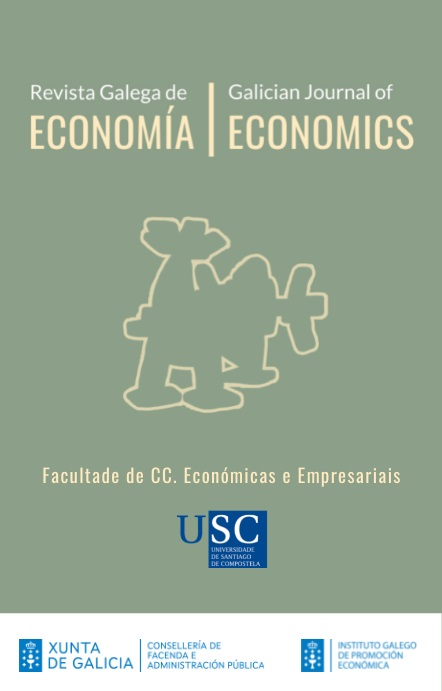The coronavirus: Black swan and endowment shock
Contido principal do artigo
Resumo
An external shock caused by an extraordinary and unpredictable effect, a “black swan” like COVID-19, is analyzed. It implies a shift of endowment in financial markets, and its effects on economic inequality, financial deepening and total economic income. Theoretical models are proposed, where the public sector seeks alternatives to a lockdown, allowing self-regulation of the economy, taxing capital or seeking joint policies with other states. In the first model, the economy is self-regulating with the help of the financial sector. Nonetheless, inequality is generated and in other models, the public sector tries to intervene. First, the public sector minimizes inequality by taxing capital, allowing a redistribution of wealth and income, with a tax rate that depends only on the differential impacts of the black swan on the different markets. Finally, a coordination of policies between the different countries affected is proposed to prevent black swans and other negative externalities. This is feasible depending on the tax rate, household benefits and administration costs
Palavras-chave:
Detalles do artigo
Referências
Adams-Prassl, A., Boneva, T., Golin, M., & Rauh, C. (2020). Inequality in the impact of the coronavirus shock: Evidence from real time surveys, Journal of Public economics, 189, 104245. DOI: https://doi.org/10.1016/j.jpubeco.2020.104245
Álvarez Espiño, M., Fernández-López, S., Rey-Ares, L., & Castro-González, S. (2020). Capacitación y comportamiento financiero de la generación millennial en España. Revista Galega de Economía, 29(3), 1-19. DOI: https://doi.org/10.15304/rge.29.3.7045
Amankwah-Amoah, J., Khan, Z., & Wood, G. (2020). COVID-19 and business failures: The paradoxes of experience, scale, and scope for theory and practice. European Management Journal, 39 (2), 179-184. DOI: https://doi.org/10.1016/j.emj.2020.09.002
Benito, A. (2006). Does job insecurity affect household consumption? Oxford Economic Papers, 58(1), 157-181. DOI: https://doi.org/10.1093/oep/gpi041
Blanchard, O., & Illing, G. (2021). The COVID-19 pandemic (version January 2021). München, Germany: Pearson Studium.
Bordo, M. D., & Meissner, C. M. (2012). Does inequality lead to a financial crisis? Journal of International Money and Finance, 31(8), 2147-2161. DOI: https://doi.org/10.1016/j.jimonfin.2012.05.006
Brunnermeier, M. K., & Koby, Y. (2018). The reversal interest rate. NBER Working Paper No. 25406. Cambridge, MA: National Bureau of Economic Research (NBER). Retrieved from: https://www.nber.org/system/files/working_papers/w25406/w25406.pdf
Calvo Bernardino, A., & Martín de Vidales Carrasco, I. (2017). Crisis financiera y reestructuración de las cajas de ahorro en España, 2003-2013. Revista Galega de Economía, 26(1), 5-18. DOI: https://doi.org/10.15304/rge.26.1.4306
Carroll, C. D., & Samwick, A. A. (1998). How important is precautionary saving? Review of Economics and Statistics, 80(3), 410-419. DOI: https://doi.org/10.1162/003465398557645
Chamon, M., Liu, K., & Prasad, E. (2013). Income uncertainty and household savings in China. Journal of Development Economics, 105, 164-177. DOI: https://doi.org/10.1016/j.jdeveco.2013.07.014
Cysne, R. P. (2009). On the positive correlation between income inequality and unemployment. The Review of Economics and Statistics, 91(1), 218-226.
Davola, A. (2020). From the black swan, to the snowball. Risks of COVID-19 pandemic for consumer credit scores in the lack of a harmonized regulatory intervention. Opinio Juris in Comparatione [Forthcoming]. DOI: http://dx.doi.org/10.2139/ssrn.3604031
Furceri, D., Loungani, P., Ostry, J. D., & Pizzuto, P. (2020). Will Covid-19 affect inequality? Evidence from past pandemics. Covid Economics. Vetted and Real-Time Papers, 12, 138-157.
Galletta, S., & Giommoni, T. (2020). The effect of the 1918 influenza pandemic on income inequality: Evidence from Italy (June 24, 2020). Social Science Research Network (SSRN). DOI: http://dx.doi.org/10.2139/ssrn.3634793
Gros, D. (2020). The great lockdown: Was it worth it? CEPS Policy Insights, No. 2020-11. Brussels, Belgium: Centre for European Policy Studies (CEPS). Retrieved from: https://www.ceps.eu/wp-content/uploads/2020/05/PI2020-11_DG_The-great-lockdown.pdf
Jantti, M. (1994). A more efficient estimate of the effects of macroeconomic activity on the distribution of income. Review of Economics and Statistics, 76(2), 372-378. DOI: https://doi.org/10.2307/2109895
Küçükçayli, F. M., & Akinci, G. Y. (2020). Is COVID-19 the new black swan of the financial markets? On the linkage between COVID-19 and stock markets. Modern Economy, 201.
Lugilde, A., Bande, R., & Riveiro, D. (2019). Precautionary saving: A review of the empirical literature. Journal of Economic Surveys, 33(2), 481-515. DOI: http://dx.doi.org/10.1111/joes.12284
Menegatti, M. (2010). Uncertainty and consumption: New evidence in OECD countries. Bulletin of Economic Research, 62(3), 227-242. DOI: http://dx.doi.org/10.1111/j.1467-8586.2009.00316.x
Mocan, N. H. (1999). Structural unemployment, cyclical unemployment and income inequality. The Review of Economics and Statistics, 81(1), 122-134. DOI: https://www.jstor.org/stable/2646791
Morset, T. L. (2013). Inequality as a cause of systemic banking crises ̶ some new theory and evidence. (Master Thesis). Lund University. Retrieved from: https://lup.lub.lu.se/student-papers/search/publication/3814887
Peña, G. (2019). Efficient treatment of banking services under VAT. Economics and Business Letters, 8(2), 115-121. DOI: https:// doi.org/10.17811/ebl.8.2.2019.115-121
Perugini, C., Hölscher, J., & Collie, S. (2015). Inequality, credit and financial crises. Cambridge Journal of Economics, 40(1), 227-257. DOI: https://doi.org/10.1093/cje/beu075
Piketty, T. (1997). The dynamics of the wealth distribution and the interest rate with credit rationing. The Review of Economic Studies, 64(2), 173-189. DOI: https://doi.org/10.2307/2971708
Sayed, A., & Peng, B. (2020). Pandemics and income inequality: A historical review. Covid Economics. Vetted and Real-Time Papers, 52, 96-117.
Schumpeter, J. A. (1912). The theory of economic development. Cambridge, MA: Harvard University Press.
Serageldin, I. (2011). Abolishing Hunger. TATuP-Zeitschrift für Technikfolgenabschätzung in Theorie und Praxis, 20(2), 14-20. DOI: https://doi.org/10.14512/tatup.20.2.14
Taleb, N. N. (2007). The black swan: The impact of the highly improbable, vol. 2. Random House.
Vinci, A. (2008). Anarchy, failed states, and armed groups: Reconsidering conventional analysis. International Studies Quarterly, 52(2), 295-314. Retrieved from: https://www.jstor.org/stable/29734236







